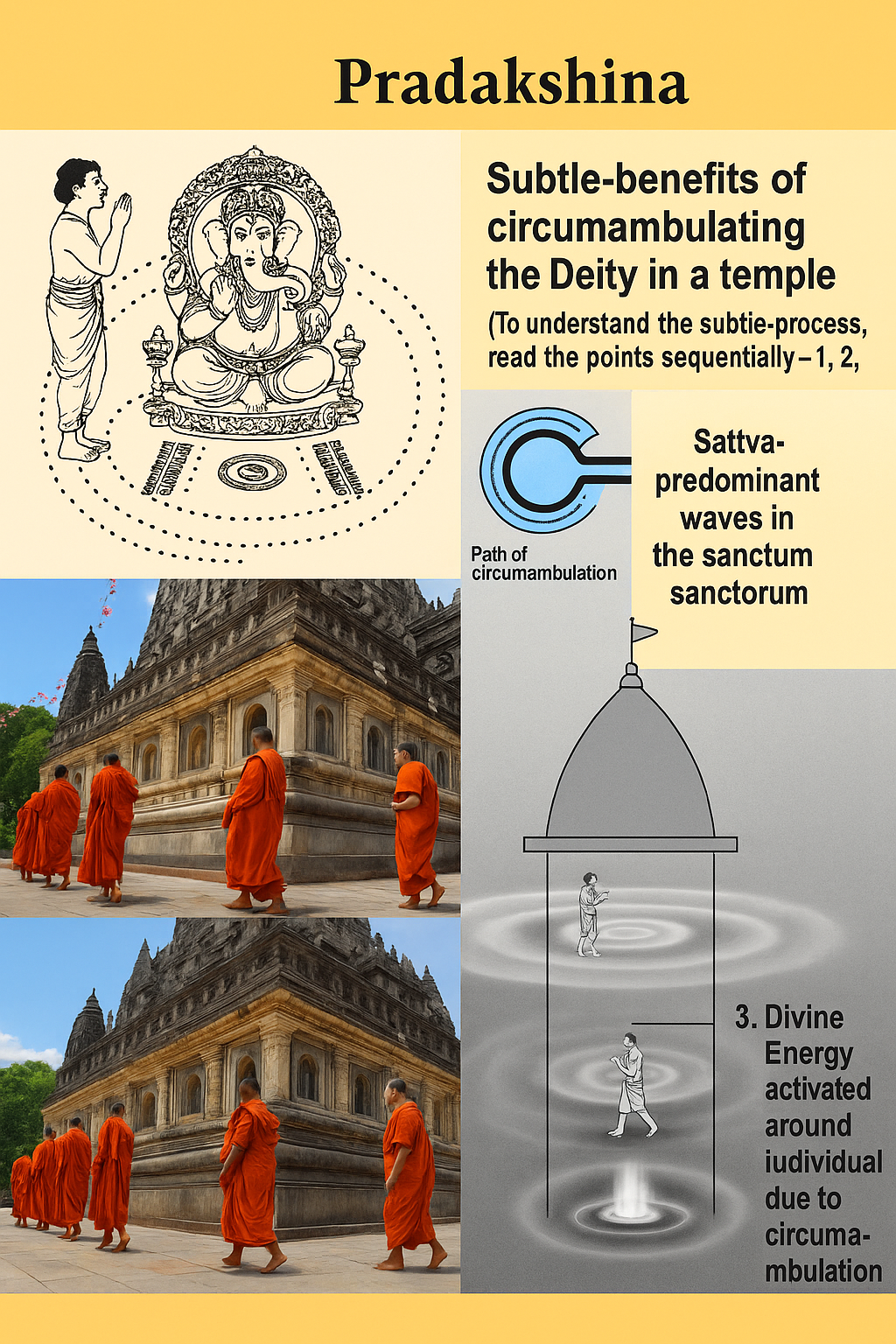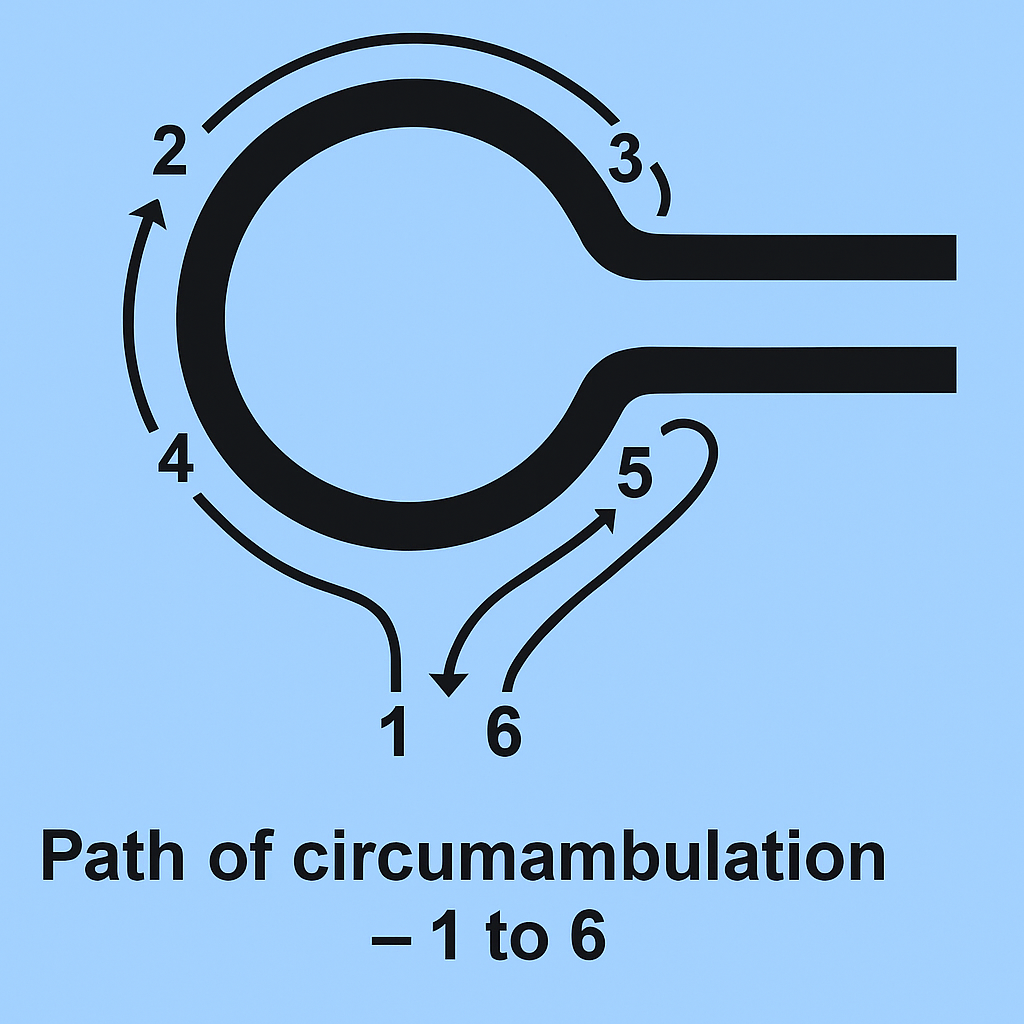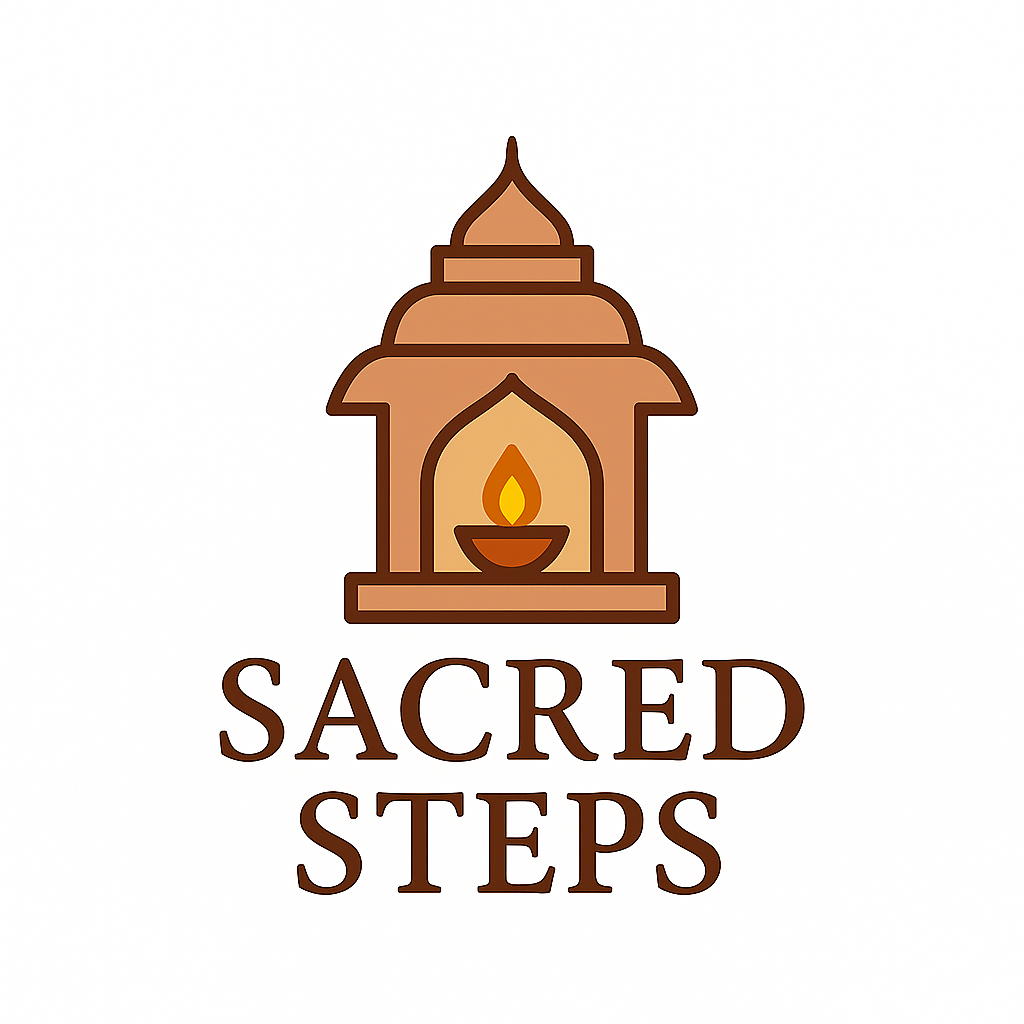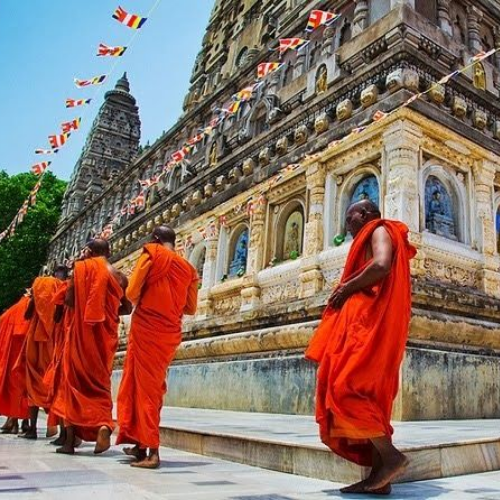Why Hindus do Parikrama around their Temples & Deities and what is the Significance of Pradakshina?
Parikrama (circumambulation) or Pradakshina is a ritual in Hinduism & some other religions in which a person circumambulates around a temple or a thing in a clockwise direction.
Why Hindus do Parikrama around their Temples & Deities and what is the Significance of Pradakshina?
'Pari’ in Sanskrit means ‘around,’ and ‘Krama’ means ‘going’. Therefore, the word Parikrama means going around. Pradakshina comprises two words, viz. ‘Pra’ and ‘Dakshina (right), which means ‘to the right’.
Many of us go to the Devalay (Temple) to have a darshan (viewing) of the Deity. In order to take maximum benefit of the darshan, one must do pradakshina (circumambulation) of the Deity.
To commence the pradakshina, one can start moving at normal pace from the left side of the garbha-gruha (Sanctum sanctorum) with hands folded in the Namaskar-mudra (Both the hands joined and held at the level of the Anahat-chakra;
To commence the pradakshina, one can start moving at normal pace from the left side of the garbha-gruha (Sanctum sanctorum) with hands folded in the Namaskar-mudra (Both the hands joined and held at the level of the Anahat-chakra;
The fourth centre in the spiritual energy flow system, located in the region of the heart in the subtle-body, but a little away from the body), while chanting the Deity’s Name.
The fourth centre in the spiritual energy flow system, located in the region of the heart in the subtle-body, but a little away from the body), while chanting the Deity’s Name.
In Shukla Paksha (15 moon days from New moon to Full moon) and Krishna Paksha (15 moon days from Full moon to New moon) the evening of the Trayodasi (thirteenth moon day) between 4.30 p.m. to 6.00 p.m. is called "Pradhosha". It comes once in fifteen moon days.
Pradhosha time is especially meant for praying to God Shiva. Praying in that time is believed to free us from all our sins and gives moksha finally (hence the name Pradhosha). During Pradosha time a special type of circumambulating called Somasutra Pradhakshinam is done.
The origin of Pradhosha is related to churning of milky ocean by Devas and Asuras.
Parikrama is done around idols, temples, trees/plants, rivers, mountains, persons, around the sacred Peepal tree, tulsi (Indian basil plant), and agni (sacred fire or the fire God), and agni parikrama is a part of the Hindu wedding ceremony. Hindus believe that every sacred object in the universe contains divine energy. Although this energy is mainly concentrated in that object, it extends to a certain distance.
Therefore, if a person goes around that object, he/she comes in contact with the aura of that sacred energy, which is very helpful, both spiritually and physically.
Parikrama in a Clockwise Direction; the right side is considered auspicious and the left inauspicious.
Hindus do not accept Prasadam in the left hand or do not touch sacred objects with it. The reason why we go clockwise is to augment our magnetic moment in the direction of the Earth's magnetic field so as to gain energy from it.
Most of temples in ancient India were not just temples.They were hubs of positive energy.The site for temples was chosen after inspection of magnetic field inthe region.People don't believe but our ancestors had applied much more of Science to things than what we even know today.
💮 Pada Pradakshina: This is the most common type of Parikrama. Pada means foot. A person needs to walk on foot around the object.
💮 Danda Pradakshina: Danda means a stick. It consists of a mixture of walking and prostration.
The person needs to take a step and then prostrate (lie flat on the ground like a stick with hands in Namaste position in front of the head). Then get up and repeat the above steps. In this way,the person has to complete all the rounds around the object. Its a bit harder to do.
💮 Anga Pradakshina: Anga means body. In this type, the person needs to prostrate as mentioned above, and roll around the object. It is one of the hardest types of Parikrama.
💮 Adi Pradakshinam: It is the same as Pada Pradakshina, but steps are taken very close, immediately next to previous footsteps without any gap between them.
💮 Agni Parikrama: The circumambulation around the fire is one of the most important rituals in a Hindu marriage.
The bride & groom circumambulate the fire in clockwise direction for 7,3, or 4 times.The ritual is called "Agniparinayana" or "Mangal Phera".
💮 Parikrama Around Plants or Trees:Vat Purnima is a Hindu festival mainly observed by a married Hindu woman for longevity of her husband.
On the day of the festival, Hindu women circumambulate a banyan tree clockwise and wind a white thread around it while doing so. Peepal is one of the sacred trees in Hinduism. Circumambulating a Peepal tree on certain days is believed to bring good luck.
Most of the Hindus have Tulsi Vrindavan in front of their houses. The ladies of the house worship her daily and circumambulate her. Tulsi is an incarnation of the goddess Lakshmi. Therefore, circumambulating a Tulsi plant pleases the goddess.
💮Parikrama of a Dead Body:
Circumambulating a dead body is an integral part of the last rites in Hinduism. The person performing the last rites holds an earthen pot filled with water on his shoulder.
Then a small hole is made in the pot, and the person circumambulates the dead body in an anti-clockwise direction once starting from the feet of the dead. After that, the second hole is made in the pot, and the person completes the second round.
Then a third hole is made and the person completes the third and the final round. After this, the person breaks the pot by dropping it backward on the ground.

Pilgrimages:There are many Hindu pilgrimages associated with Parikrama.🕉🧡
1.Narmada Parikrama.
2.Kardalivan Parikrama.
3.Govardhan Hill Parikrama.
4.Girnar Mountain Pradakshina.
5.Kurukshetra Parikrama.
6.Vraj Mandal Pradakshina.
7.Vrindavan Parikrama.
8.Char Dham Parikrama.
Rules of Parikrama:😍🙏🏻
🌸It should be done in a clockwise direction only.
🌸Do not talk to anyone while doing it.
🌸Complete a full round.
🌸Do not stop in between.
🌸If possible, chant a mantra of the deity you are circumambulating or the one mentioned below.
🌸Do not wear any footwear.
🌸Do not hurry and concentrate on the deity.
🌸Don’t let mundane thoughts disturb you.
🌸If possible,wear wet clothes. It is believed to be more beneficial.
Mantra While Doing Pradakshina:
यानि कानि च पापानि जन्मांतर कृतानि च।
तानि सवार्णि नश्यन्तु प्रदक्षिणे पदे-पदे।।
Oh God! Whatever sins I have committed all my lives (including previous lives), please destroy them with every step of Pradakshina. Mannat; Some people pledge to do certain things or give something in return to a deity if their certain wishes are fulfilled.This is called mannat.
Some of them, pledge to do a certain number of Parikrama in exchange for the fulfillment of their wishes.
All of them believe that the holy spot or image is at the very centre of life and so is the main focus of their existence.
The faithful believe that God is at the centre of our existence. So when we do pradakshina or circumambulation, we accept that our actions and thoughts are always centred on God.
The number of Parikramas; varies with the deity. Also, there are contradictions about how many rounds one should go around a deity. In general, it is believed that one should do an odd number of circumambulations of a Goddess and even numbers of a God.
The Swayambhu Agama says that doing Pradakshina 21 times to any deity is sanctified. There is a Sanskrit shloka that advises how many parikramas should be done around Hindu Gods, but the source of it is not known.
एका चंड्या रवे: सप्त, तिर्स्त्र: कार्या विनायके:।
हरेश्चतस्त्र: कर्तव्या:, शिवस्यार्ध प्रदक्षिणा ।।
A devotee should perform one circumambulation for a Goddess, seven for the Sun, three for Sri Ganesha, four for Sri Vishnu and his incarnations, and a half for Shiva.
Shiva: Half. Ganesha: 3. Hanuman: 3. Durga:
1. Vishnu and his incarnations: 4. Sun: 7. Peepal Tree: 7. Yajna: 5, 11, or 108. Kartikeya: 6. Reason for different number of
pradakshinas to be performed around a Deity ;
The general rule is that, for male Deities, the number of pradakshinas should be in ‘even’ numbers (0, 2, 4, 6), and for female Deities, it should be in odd numbers (1, 3, 5, 7).
The reason is as follows.
‘Zero’ denotes Brahman, meaning, Supreme God, who is the Creator of the universe. From ‘zero’, the number ‘one’, that is, Maya (The Great illusion), meaning, the universe has originated. Maya is feminine, and the number ‘one’ is an ‘odd number’.
Hence, pradakshina around the female Deities should be done in ‘odd’ numbers. ‘Even’ numbers are associated with ‘zero’ and hence, pradakshina around the male Deities should be done in ‘even’ numbers.
Male Deities are mostly associated with Anand or Shanti, whereas, the female Deities are mostly associated with Shakti. According to different schools of thought, the number of times a pradakshina to be performed around each Deity is different.
Some examples given here support this statement.
As per the Energy and function of the Deity:
एकंदेव्यांरवौसप्त त्रीणिकुर्याद्विनायके ।
चत्वारिकेशवेकुर्यात् शिवेचार्धप्रदक्षिणम् ।।
One pradakshina should be performed around the Goddess, seven around Sun Devalay,
three around Shri Ganapati, four around Shrivishnu and a half around Shiva Devalay.
Shrivishnu: Four pradakshinas have been prescribed for Shrivishnu, because Vishnu Principle contains the Divine energies of four actions of invocation, recitation, songs of praise and protection.



